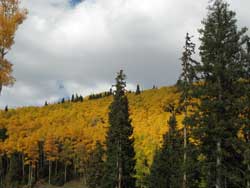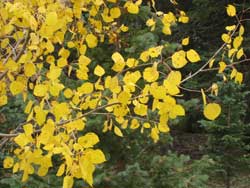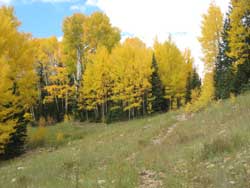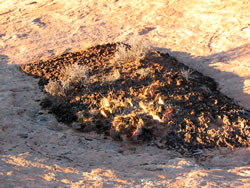HIKING HAPPENINGS
November 2008
Gold Basin – Fall Remembrances
by Marcia Hafner
 In the La Sal Mountains fall is a fleeting season that only lasts two to three weeks. That’s when the oaks flame burgundy red, the box elders fade to a soft yellow and the rose hips turn to a deep orange-red; but the biggest crowd pleaser, by far, is the rich, glittering gold of the aspens. The prime time for viewing the aspen show of gold is mid-September to early October. By the middle of October the leaves are dropping fast. Some years are better than others, and an early cold snap can shut down the performance before it even starts. This fall, however, conditions were perfect and the audience, which came up to the La Sal Mountains to witness this dazzling display, gave it rave reviews. In the La Sal Mountains fall is a fleeting season that only lasts two to three weeks. That’s when the oaks flame burgundy red, the box elders fade to a soft yellow and the rose hips turn to a deep orange-red; but the biggest crowd pleaser, by far, is the rich, glittering gold of the aspens. The prime time for viewing the aspen show of gold is mid-September to early October. By the middle of October the leaves are dropping fast. Some years are better than others, and an early cold snap can shut down the performance before it even starts. This fall, however, conditions were perfect and the audience, which came up to the La Sal Mountains to witness this dazzling display, gave it rave reviews.
Cold tolerant and fast growing (two to five feet per year), aspens are widely distributed over much of North America, with Utah and Colorado the home base for the largest portion of natural acreage in the world. Their heart-shaped leaves are uniquely attached to a flexible, lengthwise stem. This anatomy provides them the freedom of movement to rustle in the slightest breeze, a charming characteristic referred to as “quaking.” It’s the shortening of daylight that triggers the dramatic change from green to gold. That’s the signal for the chlorophyll to fade, followed by the breaking through of the brilliant yellow pigments called carotenoids that we find so mesmerizing in the fall.
 Thick groves of aspens on the Gold Basin Trail make it a good choice for an easy- going walk to savor this short-lived annual event. Since no appreciable mineral wealth has ever been exploited in the southern La Sal Mountains, it must have gotten its name for this rich autumn brilliance. For those peak baggers in the crowd, Gold Basin, at 10,000 feet, is a good access point to ascend Mount Tukunikivatz, Mellenthin Peak and Laurel Peak. To get there, go south on Highway 191 for approximately eight miles. Then turn left at the Ken’s Lake-La Sal Loop Road sign and go right at the dead-end, which becomes the La Sal Loop Road. After a big elevation gain, turn right on the Geyser Pass Road, which is graded and passable for all vehicles. The turn off for Gold Basin is 7.5 miles up the Geyser Pass Road, and it is 6.5 miles to the end of that road where a sign indicates the beginning of the trail to the left of the logs. Thick groves of aspens on the Gold Basin Trail make it a good choice for an easy- going walk to savor this short-lived annual event. Since no appreciable mineral wealth has ever been exploited in the southern La Sal Mountains, it must have gotten its name for this rich autumn brilliance. For those peak baggers in the crowd, Gold Basin, at 10,000 feet, is a good access point to ascend Mount Tukunikivatz, Mellenthin Peak and Laurel Peak. To get there, go south on Highway 191 for approximately eight miles. Then turn left at the Ken’s Lake-La Sal Loop Road sign and go right at the dead-end, which becomes the La Sal Loop Road. After a big elevation gain, turn right on the Geyser Pass Road, which is graded and passable for all vehicles. The turn off for Gold Basin is 7.5 miles up the Geyser Pass Road, and it is 6.5 miles to the end of that road where a sign indicates the beginning of the trail to the left of the logs.
An immediate sharp drop gets you started in a hurry, but it quickly mellows out to a long flat stroll. In about 200 yards, there’s a split. The right fork leads to a nice meadow, which is only good for a short side hike. For a longer hike on the main trail, turn left into the protective cover of evergreens. This old road wanders next to Brumley Creek, and I’ve read that a man named Brumley had a sawmill at the upper end of Gold Basin. This trail has not been maintained and fallen logs occasionally block the way, but scrambles over or detours around them are not difficult.
 Gradually the old road narrows down to a single track and slips through a blend of small meadows, aspens, firs and spruce with the occasional view of Mount Tukunikivatz. An old wooden, barbed wire fence suggests that the easy part is over. After that piles of rock obliterate a good portion of the trail. Eventually it dead-ends at a carved out, sheer rock-walled cirque that is surrounded by some of the highest peaks in the La Sals. Gradually the old road narrows down to a single track and slips through a blend of small meadows, aspens, firs and spruce with the occasional view of Mount Tukunikivatz. An old wooden, barbed wire fence suggests that the easy part is over. After that piles of rock obliterate a good portion of the trail. Eventually it dead-ends at a carved out, sheer rock-walled cirque that is surrounded by some of the highest peaks in the La Sals.
On my hike, everything said “I’m in the mood for fall,” from the dancing glow of aspen leaves to the crackling crunch of them underfoot. A few raspberries remained on the vine and I couldn’t resist sampling their tangy taste. The flowers have gone to seed, their glorious summer beauty now long gone. Even the brushy under story had dressed up for fall in its own reds, browns and pale yellows.
From the top of a dead tree, a very huffy squirrel demanded in his own assertive language - to get off his property! His scolding, non-musical chatter went on and on and never stopped until he was certain I had vacated his territory. He and the rest of his high-energy feisty brethren had been frantically gathering up their harvest of pine seeds in preparation for a long cold winter. All along the trail numerous inner core remnants, which the squirrels had tossed aside, showed the evidence of their highly productive seed gathering.
Too soon, the glorious season of fall dwindles away, but the memories of nostalgic autumn hikes linger on along with the anticipation of next year’s golden season. Now as October marches on into November, once again we witness the passing of the guard to winter, when snowfall is serious business and an accumulation of ten feet is a strong possibility, especially in the basins.
Despite the heavy snows, fierce winds and bitter temperatures that are recorded at well below zero, the La Sal Loop Road is plowed regularly and kept open all year as far as the Geyser Pass Road turn-off. The Geyser Pass Road is also kept open right up to the parking area and restrooms at 9600 feet just below the Gold Basin Jct. Four-wheel drive or chains may be necessary on the Geyser Pass Road, since the snowplows leave a few inches of snow to protect it.
For winter sports enthusiasts, the snow packed road to the pass and on to Dark Canyon Lake is popular for sledding, cross-country skiing, and snowboarding. Winter backcountry users should call 435-259-SNOW for the latest weather and road conditions.
|
Biological Soil Crust (aka)
Cryptos (krip’ tose):
The surface of
Moab’s desert is held
together by a thin skin of living organisms known as cryptobiotic
soil or cryptos. It has a lumpy black appearance, is very
fragile, and takes decades to heal when it has been damaged.
This soil is a critical part of the survival of the desert.
The cryptobiotic organisms help to stabilize the soil, hold
moisture, and provide protection for germination of the seeds
of other plants. Without it the dry areas of the west would
be much different. Although some disturbance is normal and
helps the soil to capture moisture, excessive disturbance
by hooves, bicycle tires and hiking boots has been shown
to destroy the cryptobiotic organisms and their contribution
to the soil. When you walk around Moab avoid crushing the
cryptos. Stay on trails, walk in washes, hop from stone to
stone. Whatever it takes, don’t crunch the cryptos
unless you absolutely have to! |

Cryptobiotic soil garden
|
|
|